5 Swimming Drills for Runners
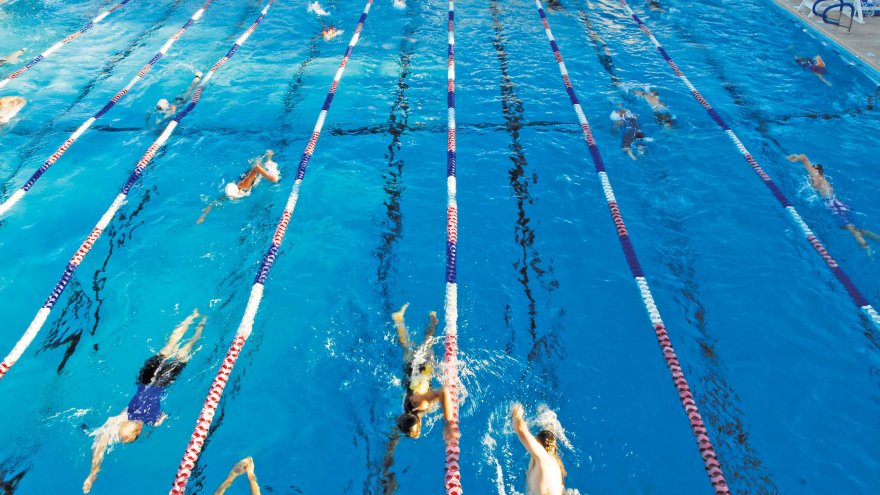
Some runners hit the pool for cross-training and recovery days. Others are begrudgingly in the water due to commands from their doctor or coach for injury rehabilitation. Regardless of what motivates you, swimming can be an excellent tool to improve running economy, hip and core strength, boost heart health, prevent or nurse injuries, and much more.
Many runners complain that starting at the line on the bottom of the pool is boring (which may be a little bit true) but there’s still a lot of ways to have fun in the water without dreading every pool workout. The key is to include a variety of components in your water workout to spice it up and simultaneously maximize impact in carry-over to running.
You don’t have to know all the “lingo” or how to read intervals on the clock to start swimming laps. However, it is helpful to know that most standard pools are 25 yards long. (Some are 25 meters, and rarely you’ll find one the Olympic size of 50 meters). Thus, in a 25-yard pool, if you complete one lap (down and back) in the pool, that is 50 yards, two laps is 100 yards, etc.
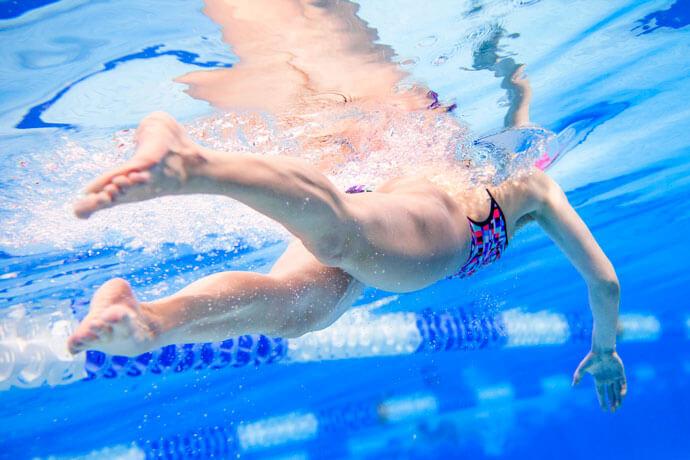
It’s good to incorporate various aims including speed and technique work into a swimming workout. Just like running, a warm-up and cool-down is important. Right after the warm-up, it’s beneficial to do some swimming drills. It’s also important to include time in the workout where you are kicking only. Avoid the temptation to use fins or paddles the whole time, which can lead to overuse injuries. Also avoid doing too much “pulling” with a pull buoy until you are sure your technique is spot-on. Incorporate a little of bit of speed into the tail end of your warm-up, before the “main set.” The main set typically depends on the day, and could be more aerobically focused, a sprint workout, or perhaps some work on other strokes besides freestyle. Always finish up with a cool-down.
If you’re not feeling interval-ready, you can simply take about 5-15 seconds rest between each repetition, and a minute or so between each set.

A sample hour workout for a lap swimmer looking to do 2,000 yards could look like this:
- 200 freestyle
- 4×50 – kick on your back, arms streamlined
- 8×50 – 25 drill* of your choice, 25 freestyle (*see drill ideas below)
- 8×25 – alternate with “fast-easy” and “easy-fast” for each 25 (so, you sprint one half of each 25)
- 8×100 – freestyle, build to race pace
- 4×50- backstroke drill* (*see drill ideas below) for cool-down
Drills are designed to help swimmers focus on certain aspects of technique. Each drill typically has a specific focus that aims to improve muscle activation and efficiency. Below are 5 drills that are ideal for runners, whether you’re new to the sport of swimming or have an experienced background in it. These drills should leave your legs burning – you’ll be surprised at how much of a “leg” sport swimming can be!
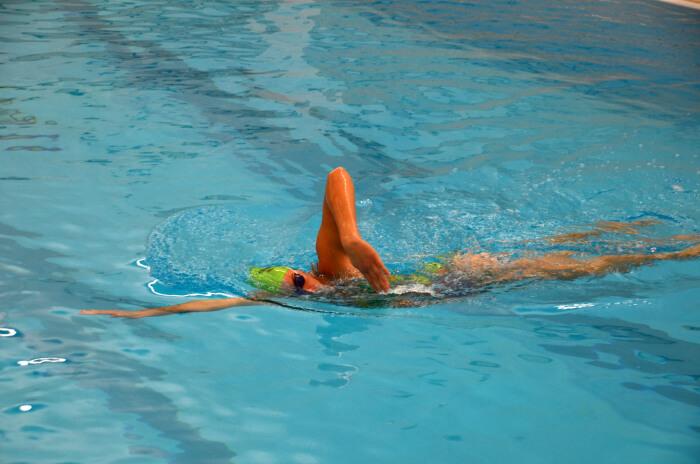
1) Fingertip Drag Drill
While swimming freestyle, as your hand exits the water, keep it low and skim the surface of the water with your fingertips lightly, maintaining a high elbow position, until your hand is at the position in front of you where you start your next stroke. By maintaining a high elbow position above the hand, your body rotates slightly more, you have less strain on your rotator cuff, and you rely more on your core and hip muscles for power.
2) Triple-Side Kick Drill
With your arms down at your sides, kick your way down the pool, alternating your body position to perform 8 flutter kicks while rotated on your right side, 8 flutter kicks on your stomach (face down), and 8 flutter kicks while rotated on your left side, then back to 8 flutter kicks on your stomach, 8 on your right side, etc. Try to incorporate a brief breath as you roll to each side as you’re starting your 8 kicks. By removing the arms from the drill and spending time on each side, you not only enhance the core initiation of your body roll and get to practice rotation, but you can get a glimpse into whether your kick is efficient or not. If you find that your body is doing a lot of lateral or stationary motion instead of a smooth advancement down the pool, it may be that you are bending your knees too much while you kick. Remember that flutter kicking should be “tight knees, loose ankles” and the emphasis should come from your glutes!
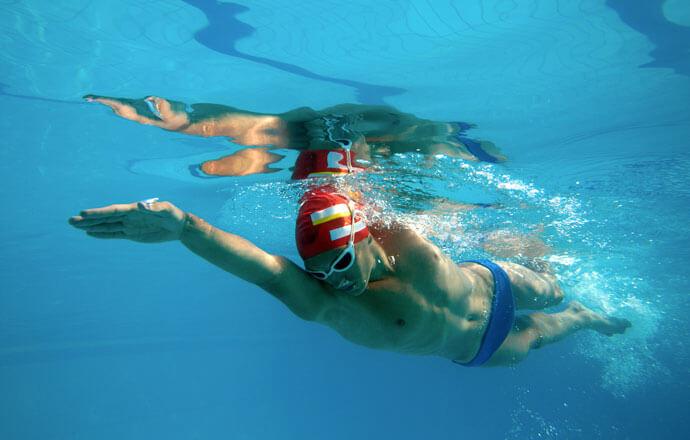
3) Distance per Stroke Drill
Start by swimming one length of the pool and count your arm strokes. Then take the number you got and decrease it by 2-4. Complete another length and see if you can reach your new goal number. Over time, this should foster an improved stroke efficiency. It’s also helpful for getting in the habit of activating the legs with lots of kicking right off the wall when you start each length. And, if you increase your kicking tempo and hip / core activation with your body roll, you should be able to reach that goal number fairly easily with better form.
4) Backstroke Drill
Begin by swimming backstroke (check to make sure there are flags up before you do this one, so you don’t run into the wall on the other end!) Focus on a steady “6-beat” kick. This means that for every stroke cycle, which is 2 arm strokes, you kick 6 times. (Or, 3 kicks per each one arm rotation). The goal is to maintain a constant kick, without pausing as you rotate your hips. This enables you to propel more of the stroke from that core and hip area as opposed to the shoulders.
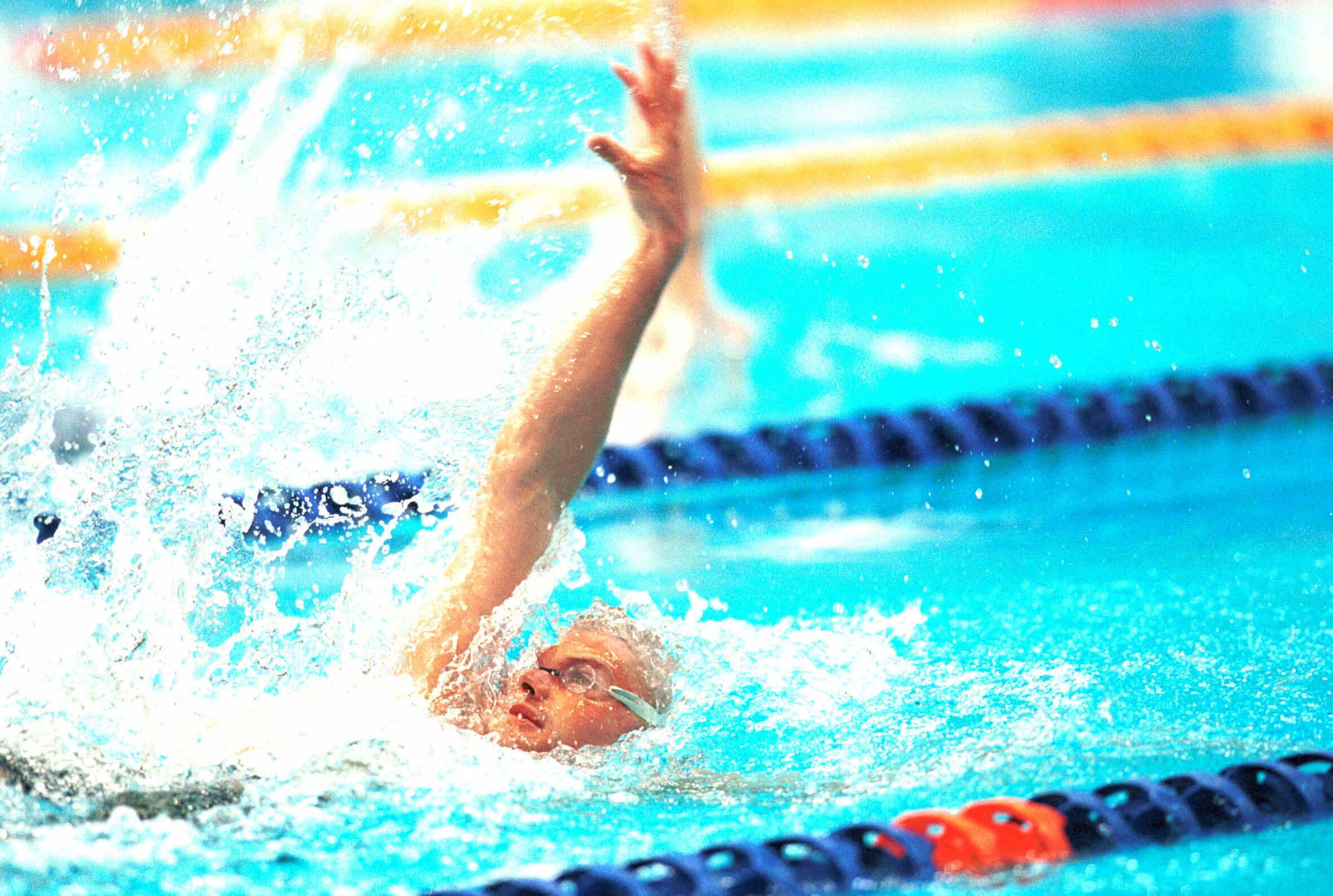
5) Body roll drill
Swimming freestyle, pause on your side after every 3 arm strokes and perform 8 flutter kicks before continuing on. By performing this rotational pause and kick every 3 strokes, you will get to practice rotation on both your right and left side. Think about moving your hips and shoulders as one unit, initiate the rotation from your hips and core so that you’re not twisting, and maintain your head stationary and facing down as your body rotates (aside from when you breathe)
Latest Articles
 Is Running on a Treadmill Easier Than Running Outside?Runners have their own preferences, whether it is treadmill running, running outside on the road, or exploring trails. So...
Is Running on a Treadmill Easier Than Running Outside?Runners have their own preferences, whether it is treadmill running, running outside on the road, or exploring trails. So... Is It OK to Use Trail Running Shoes on the Road?While trail running shoes can be used on roads, especially in situations where a runner encounters mixed terrains or pref...
Is It OK to Use Trail Running Shoes on the Road?While trail running shoes can be used on roads, especially in situations where a runner encounters mixed terrains or pref... How to Fix Sore Quads After Running?Rest, ice, gentle stretching, and over-the-counter pain relievers can help soothe sore quads after running. Also, ensure ...
How to Fix Sore Quads After Running?Rest, ice, gentle stretching, and over-the-counter pain relievers can help soothe sore quads after running. Also, ensure ... 10 Fruits With The Most Electrolytes to Replace Sports DrinksThese fruits are high in electrolytes such as potassium, magnesium, and calcium, essential for hydration, muscle function...
10 Fruits With The Most Electrolytes to Replace Sports DrinksThese fruits are high in electrolytes such as potassium, magnesium, and calcium, essential for hydration, muscle function...

